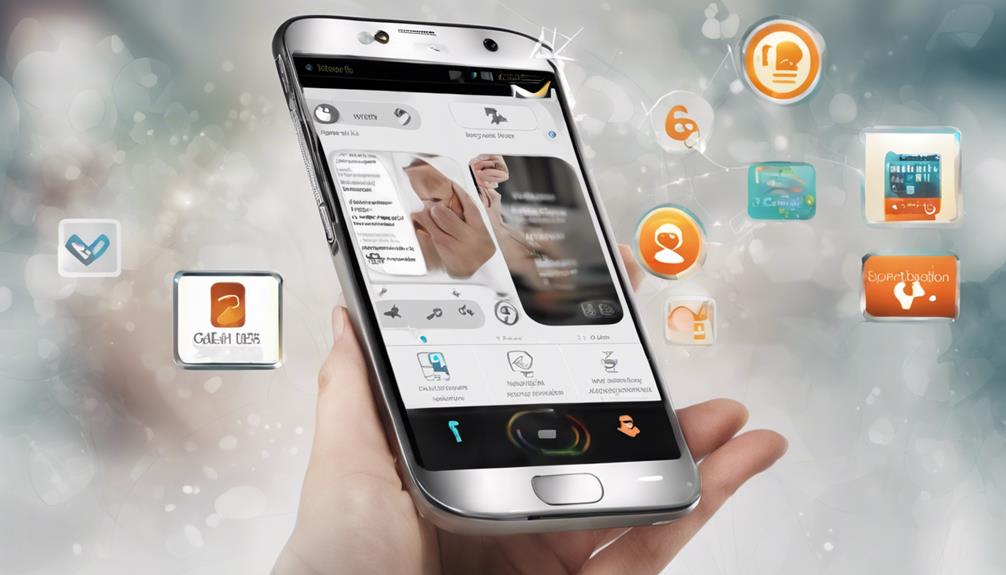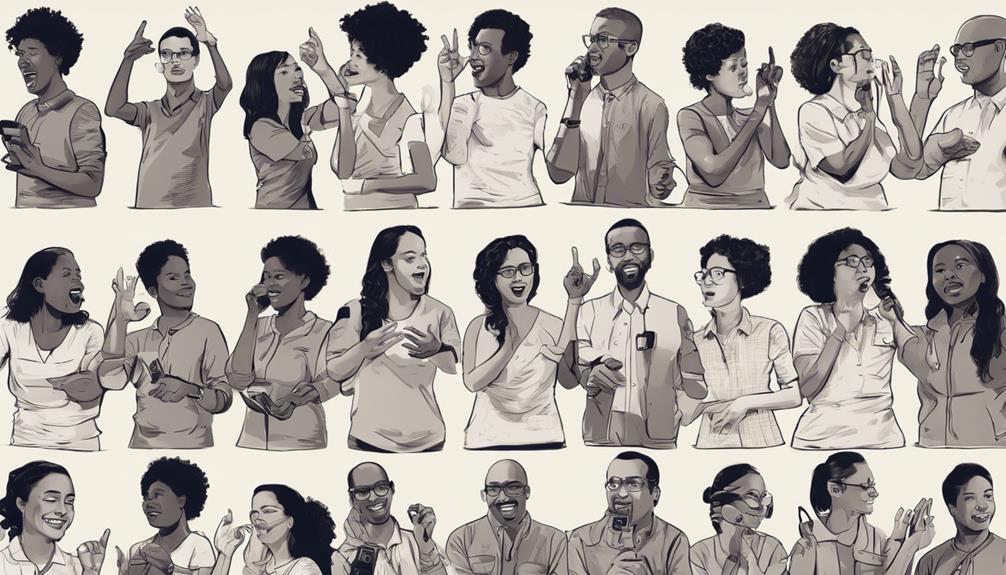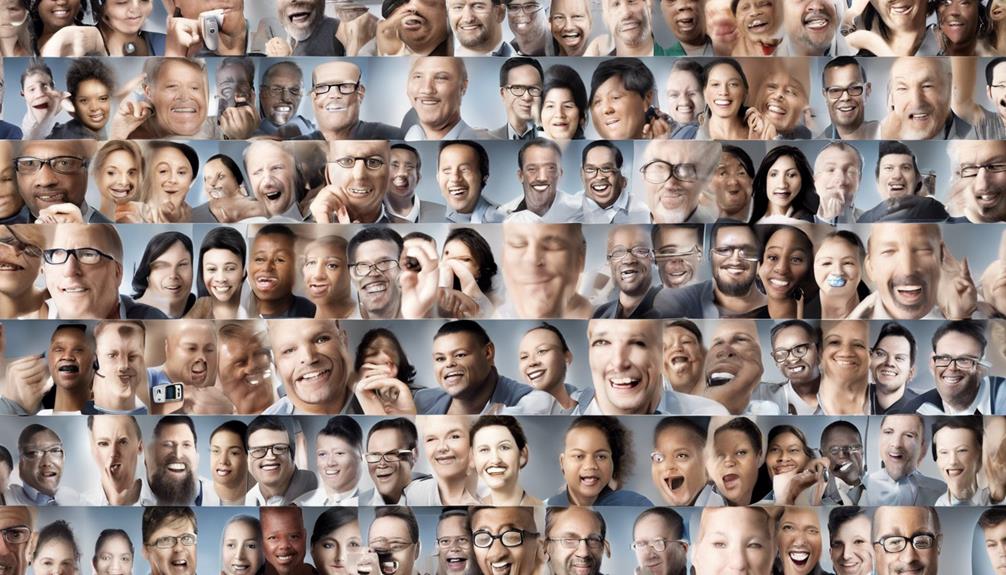The phrase “necessity is the mother of invention” holds true when it comes to creating essential tools for deaf individuals. Innovation plays a crucial role in improving their daily lives.
From devices that alert you to important sounds in your environment to cutting-edge communication tools, the world of gadgets for the deaf is vast and continuously evolving.
Discover how these technological marvels not only bridge communication gaps but also pave the way for a more inclusive and connected future.
Key Takeaways
- Visual Alert Systems enhance safety and awareness for deaf individuals.
- Communication Devices facilitate effective interaction and accessibility.
- Hearing Aids and Cochlear Implants optimize communication based on specific needs.
- Mobile Applications promote inclusivity and seamless communication experiences.
Visual Alert Systems
Visual alert systems are indispensable tools that utilize flashing lights and vibrations to notify deaf individuals of various sounds and events in their surroundings. These assistive devices, also known as alerting devices, play a crucial role in ensuring that deaf individuals are alerted to important auditory signals like doorbells, phone calls, and alarms. Moreover, visual alert systems contribute significantly to enhancing safety and security by providing visual cues for emergencies such as fire alarms or carbon monoxide alerts.
These devices come in different forms, offering a range of signaling methods including strobe lights, vibrating devices, and LED displays. By translating auditory information into visual cues, visual alert systems effectively bridge the communication gap for deaf individuals. This not only promotes independence but also increases awareness of their environment. The ability of these systems to convey essential information visually is paramount in empowering deaf individuals to stay informed and safe in various situations.
Communication Devices

Communication devices play a pivotal role in facilitating seamless interaction and enhancing accessibility for deaf individuals in various communication scenarios. These gadgets cater to different needs, from sign language interpretation to text-to-speech capabilities. Sign language translation apps provide real-time interpretation, while captioning devices offer text captions for multimedia content. Here's a breakdown of essential communication devices for the deaf:
| Communication Devices | Description |
|---|---|
| Sign Language Translation Apps | Real-time interpretation of sign language for better communication in conversations. |
| Text-to-Speech Devices | Converts written text into spoken words, aiding in verbal communication for deaf individuals. |
| Captioning Devices | Display text captions for videos, TV shows, and movies, enhancing multimedia content accessibility. |
Moreover, advanced hearing aid technology is crucial for clear sound amplification and customization, ensuring improved communication in various environments. These devices collectively empower deaf individuals to engage effectively in conversations and access information seamlessly.
Hearing Aids and Cochlear Implants

How do hearing aids and cochlear implants differ in their function and suitability for individuals with hearing loss?
Hearing aids are essential assistive technology for many individuals with hearing loss. These electronic devices come in various styles, such as behind-the-ear (BTE), in-the-ear (ITE), and completely-in-the-canal (CIC), providing amplification to help with different degrees of hearing loss.
On the other hand, cochlear implants are surgically implanted devices that directly stimulate the auditory nerve, making them suitable for individuals with severe to profound hearing loss who don't benefit significantly from hearing aids.
While hearing aids amplify sounds, cochlear implants bypass damaged portions of the inner ear to provide sound signals to the brain. Audiologists play a crucial role in evaluating individuals for both hearing aids and cochlear implants, ensuring a proper fit and optimal performance.
It's essential to have a thorough assessment to determine the most suitable option based on the individual's specific hearing needs.
Mobile Applications

Mobile applications play a crucial role in enhancing accessibility and communication for the deaf community.
These apps offer a range of features such as real-time captioning services during phone calls, sign language keyboards for texting, and speech-to-text translation capabilities.
Accessibility Features in Apps
Enhancing accessibility for deaf individuals, mobile applications with real-time captioning provide text-based representations of audio content. Apps like Ava and Google Live Transcribe offer speech-to-text features, converting spoken words into written text for seamless communication.
These features not only aid in understanding spoken language but also facilitate smoother interactions in various settings. Additionally, communication apps such as Glide and Marco Polo enable users to send video messages using sign language, promoting visual communication and inclusivity.
Video relay services like Purple VRS and Convo further enhance accessibility by allowing deaf individuals to make phone calls with sign language interpreters. Social media platforms like Instagram and Facebook also contribute by offering closed captioning features for videos, ensuring content is more accessible to the deaf community.
Communication Tools for Texting
Transitioning from accessibility features in apps, communication tools for texting through mobile applications offer deaf individuals various avenues to enhance their communication skills and connect with others efficiently.
- ASL App and Marlee Signs: Provide easy access to American Sign Language resources.
- Ava and Google Live Transcribe: Offer real-time speech-to-text capabilities for engaging in conversations.
- InnoCaption and Hamilton Mobile CapTel: Display captions during phone calls, aiding seamless communication.
- WhatsApp and Facebook Messenger: Allow texting, emojis, and multimedia messages.
- Hand Talk and ProDeaf Translator: Provide sign language translation services for bridging communication gaps.
These assistive technologies empower the deaf community by facilitating effective communication through text, sign language, and real-time transcription tools.
Navigation and Travel Aids

If you're a deaf individual seeking aids for navigation and travel, consider GPS tracking devices for accurate location information and alerts.
Wearable vibrating directional gadgets can help you stay oriented in unfamiliar surroundings.
Sign language interpreter apps can also be invaluable for seamless communication in public transportation or when asking for directions.
GPS Tracking Devices
GPS tracking devices designed for deaf individuals offer real-time location information. They empower users with visual alerts and haptic feedback for safe and efficient navigation and travel. These devices enhance independence and confidence in travel by providing customized settings for preferences like route selection.
Integration with public transportation apps improves accessibility in urban environments, ensuring seamless movement. The technology in GPS tracking devices is a game-changer, allowing deaf individuals to navigate surroundings with ease. With these gadgets, landmarks are easily identified, making navigation simpler and more enjoyable.
Experience the freedom of traveling independently, knowing that real-time guidance and support are just a glance or vibration away.
Vibrating Directional Wearables
Enhance your navigation and travel experience with vibrating directional wearables designed to provide haptic feedback for deaf individuals. These innovative devices offer haptic feedback through vibrations, guiding you with alerts for left and right turns or straight paths. By enhancing spatial awareness, vibrating directional wearables assist in navigating unfamiliar surroundings seamlessly.
Some models even incorporate GPS technology, granting real-time location details and route suggestions. Ultimately, these gadgets foster independence and confidence during travel by discreetly offering hands-free navigation support. Embrace the convenience and efficiency of vibrating directional wearables to empower your journeys with enhanced guidance and ease of movement.
Sign Language Interpreter Apps
Sign Language Interpreter Apps provide invaluable real-time translation services for deaf individuals, significantly enhancing communication and aiding in navigation and travel.
- These apps offer navigation assistance by translating spoken directions into sign language, aiding in travel for the deaf.
- Features like voice recognition technology and customizable signing styles make these apps versatile and user-friendly.
- Some interpreter apps include additional functions like text-to-speech capabilities and offline mode for accessibility in different scenarios.
- Sign language interpreter apps bridge communication gaps by facilitating seamless interactions between deaf and hearing individuals.
- They play a vital role in enhancing the independence and confidence of individuals with hearing loss within the deaf community.
Educational Tools

In today's advanced technological landscape, educational tools tailored for deaf individuals have revolutionized language learning and communication accessibility. Tools like Sign-iO offer interactive sign language learning experiences, enabling deaf individuals to enhance their language development effectively.
Commu serves as a communication device that aids deaf users in communicating efficiently across various settings, fostering social interaction and educational success. Additionally, the Parenting Communication Companion provides crucial parental support by incorporating visual tools to improve communication with deaf children.
These educational gadgets play a vital role in promoting language development, enhancing social interactions, and ultimately contributing to the educational achievements of the deaf community. Through innovative technology embedded in these tools, deaf individuals can access information and resources crucial for personal growth, empowering them to navigate the world with confidence and competence.
The Future of Gadgets for the Deaf

Advancing beyond the current educational tools tailored for deaf individuals, the future of gadgets for the deaf promises integration of artificial intelligence for enhanced speech recognition and translation capabilities. As technology evolves, these devices will continue to help people with hearing impairments in various aspects of their lives.
Here are some exciting possibilities on the horizon:
- Wearable Biometric Sensors: Devices equipped with biometric sensors could help monitor health indicators and alert deaf individuals to important changes.
- Smart Home Innovations: Future smart home gadgets may feature advanced visual alert systems and gesture-controlled interfaces for seamless interaction.
- Augmented Reality (AR) and Virtual Reality (VR): Applications in AR and VR could revolutionize how deaf individuals communicate and experience the world around them.
- Brain-Computer Interfaces: Emerging technologies like brain-computer interfaces may offer innovative ways for deaf individuals to interact with devices and communicate effectively.
- Enhanced Communication Tools: Gadgets in the future may provide even more sophisticated ways to aid people in overcoming communication barriers.
Exciting advancements lie ahead, promising a more inclusive and accessible future for the deaf community.
Challenges and Considerations

When considering gadgets for deaf individuals, it's crucial to address challenges like accessing auditory information and ensuring effective communication.
You need to think about compatibility with existing devices, ease of use, and integration into daily routines.
Prioritizing clear communication, visual alerts, and vibration feedback is essential for enhancing the interaction experience.
Communication Tools for Deaf Individuals
Deaf individuals encounter significant obstacles in verbal communication due to their hearing impairments, necessitating the use of specialized communication tools for effective interaction. To bridge these gaps, consider the following essential communication tools:
- Videophones: Enable deaf individuals to communicate using sign language or lip-reading.
- Text-to-speech devices: Convert written text into spoken words, aiding communication with non-signers.
- Visual alert systems: Notify deaf individuals of sounds through flashing lights and vibrations.
- Assistive devices: Such as hearing aids and cochlear implants enhance sound perception.
- Technology: Plays a crucial role in promoting inclusivity by bridging communication barriers for individuals with hearing impairments.
Accessibility Features in Gadgets
To enhance accessibility in gadgets for deaf individuals, incorporating features such as visual alerts, vibrations, and flashing lights is crucial for effective information conveyance. Challenges arise in ensuring compatibility with assistive devices like hearing aids and cochlear implants.
When designing gadgets for the deaf community, considerations focus on user-friendly interfaces, customizable settings, and seamless integration with communication tools. Gadgets with accessibility features prioritize clear displays, adjustable volume controls, and tactile feedback for enhanced usability.
Inclusive design principles guide the development of gadgets for deaf individuals, emphasizing equal access, communication clarity, and user empowerment. By addressing these challenges and considerations, gadgets can better cater to the diverse needs of the deaf community, fostering inclusivity and independence.
Assistive Technology Options
Considering the challenges and considerations surrounding assistive technology options for deaf individuals, it's essential to prioritize compatibility, ease of use, and effectiveness in meeting specific needs. When choosing assistive devices, keep in mind the following factors:
- Compatibility with existing technology
- Ease of use for seamless integration into daily routines
- Effectiveness in meeting specific communication needs
- Cost considerations for budget-friendliness
- Maintenance requirements for long-term functionality
Devices designed for the hard of hearing, such as vibrating alarm clocks, captioning systems, and visual alert devices, play a crucial role in enhancing independence and safety. By understanding these considerations and exploring the available options, you can select the best assistive technology to improve your quality of life.
Community and Support

Support groups within the deaf community offer essential training and advocacy, driving advancements in technology and resources to improve communication challenges.
Deaf support groups play a crucial role in fostering a supportive environment that promotes inclusivity and understanding of deaf culture. Through advocacy efforts, these groups contribute to research and development, leading to enhanced quality of life for the deaf community.
Family, friends, and community support are fundamental for the acceptance and integration of technology that benefits the deaf population. Building awareness, providing sign language training, and encouraging empathy towards deaf individuals are key aspects promoted by these support groups.
Entertainment Gadgets

Community support has paved the way for the development and utilization of innovative entertainment gadgets catering to the unique needs of deaf individuals. These gadgets are designed to enhance the entertainment experience for the deaf community in various ways.
Here are some must-have entertainment gadgets for deaf individuals:
- Subtitle glasses: Providing real-time captions for movies and TV shows, these glasses enhance the entertainment experience by displaying subtitles directly in the user's line of sight.
- Vibrating alarm watches: Alerting deaf users discreetly, these watches ensure punctuality and time management without disturbing others.
- TV sound bars with speech enhancement: Clarifying dialogue for better understanding, these sound bars improve the viewing pleasure of TV shows and movies.
- Portable captioning devices: Displaying subtitles on-the-go for live events and presentations, these devices facilitate accessibility in various entertainment settings.
- Vibrating gaming controllers: Offering tactile feedback for deaf gamers, these controllers enhance immersion and the overall gaming experience.
Frequently Asked Questions
What Are the Gadgets for Deaf People?
You need gadgets that cater to your unique needs. Vibrating alarm clocks, assistive listening devices, video relay services, captioning systems, and sound amplification devices are must-haves for deaf individuals. They enhance your daily experiences and communication.
What Equipment Does a Deaf Person Need?
You need gadgets like vibrating alarm clocks, videophones, captioning systems, hearing aids, and smartphones with accessibility features. Each one plays a vital role in enhancing your communication, connectivity, and overall independence as a deaf individual.
What Are the Best Inventions for Deaf People?
You need devices like vibrating alarm clocks, captioned telephones, video relay services, hearing aid accessories, and sign language apps. These gadgets help you wake up, communicate effectively, access phone services, improve audio clarity, and learn sign language efficiently.
What Technology Helps Deaf People?
Technology that assists deaf individuals includes communication devices like videophones and text-to-speech tools, visual alert systems for notifications, hearing aids and cochlear implants for sound clarity, sign language and captioning apps, and GPS aids for navigation.
What Gadgets are Essential for Deaf Individuals to Access Library Services?
For library services for deaf individuals, essential gadgets include video relay services (VRS) for real-time communication, closed captioning devices for media, and vibrating alert systems for notifications. These gadgets ensure equitable access to library resources and services for the deaf community.
Conclusion
In conclusion, these 10 must-have gadgets for deaf individuals are like superheroes in your pocket, ready to swoop in and save the day with their superpowers of communication, safety, and accessibility.
They're the essential sidekicks that empower you to conquer any challenge, break down barriers, and navigate the world with ease.
With these gadgets by your side, you're unstoppable in your journey towards inclusivity, independence, and a vibrant quality of life.











